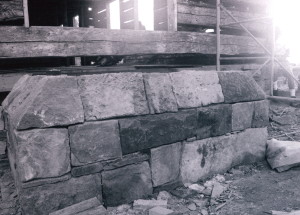Here’s a photo of the angle-cut course of stone made in order to create a wider base for the stone chimney that is to come. It’s a really nice touch to add to any chimney.
I’ve never read why the masons of old added this feature on the finer chimneys of that era, but I would imagine it was a way to further strengthen and stabilize these monuments.. and that is what a well-built chimney is, a monument. A chimney often stands long after a home is gone.
Folks back then paid more attention to nature than we do today and Incorporated those observations into their homes. Take a look at the tallest living structures that you encounter on a daily basis… trees. Notice how they flare out at the base?
It’s little details like this that will bring joy to you and for the generations to come. This handcrafted detail is right down there near the ground and is something that catches your eye every time you walk by it. New visitors always comment about it and often go over to touch it.
But it’s not without cost, it takes effort for you to get it in your plans, it takes extra materials, but most of all it’s about extra labor, it takes a mason days and days, with a hammer and chisel in hand, to create it. There is nothing like breaking the budget on day one… but IT”S WORTH IT !
Originally posted 2015-02-06 17:15:07.


In the picture chimney base are those dry stacked stones for the base?
I have found 2 old fireplace chimneys and the owner said their dry stacked. The cabin was built in 1835.
Old chimneys were built in the dry-stack method using all the principles of good solid stone masonry.
Those that did not have access to cement (which is a modern material) would often use clay or dirt and then mix in a bit of lime (if they could get it, or make it, or afford to buy it). The lime made it more durable.
If they couldn’t get lime they would just use clay or dirt alone. The reason they would use clay would be to keep the fire and smoke within the chimney… and to keep the rain and wind out of it.
The clay did not add strength to the chimney such as cement would… but by using clay… technically the stonework can’t be called dry-stack.
Often a lot of the clay infill washes out as the years go by and so the chimneys often look dry-stacked… and remember, they used dry-stack techniques… so it’s kind of a shame to not call them dry stacked… BUT… None of us would want to build a truly dry-stacked chimney, nor be in a home with a fire going in a dry-stacked chimney… as it likely will burn the home down.
I hope all of this helps!
It’s a great question with no perfect answer!
Noah